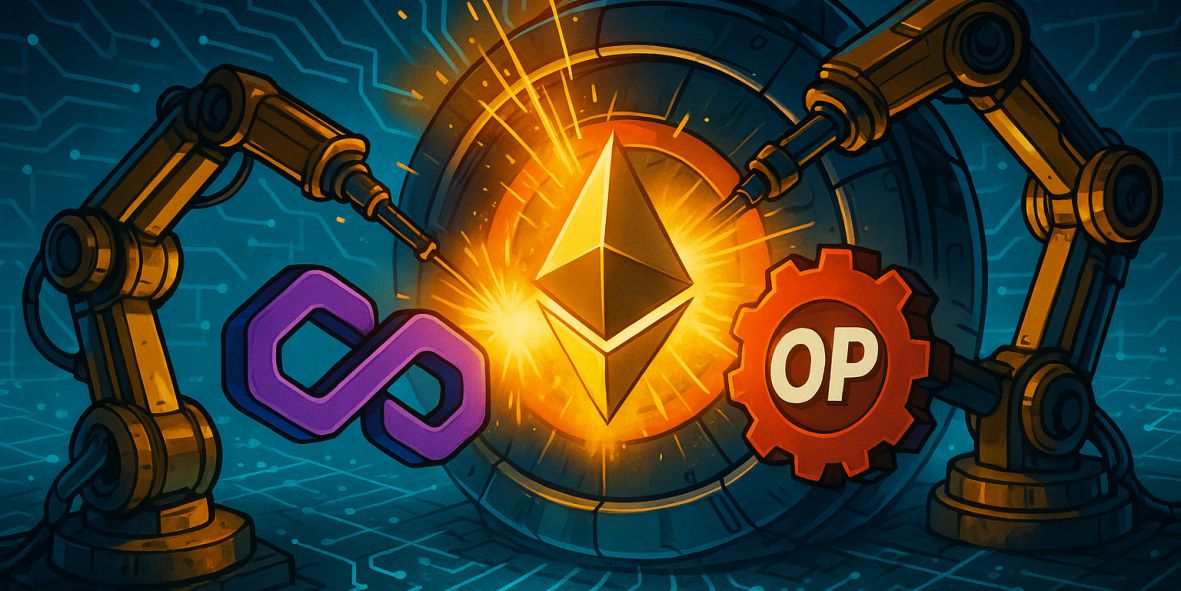Key Takeaways:
- Polygon CDK adds OP Stack compatibility, enabling developers to build multichain L2s.
- AggLayer connects OP Stack chains to Polygon’s ecosystem, enhancing cross-chain liquidity.
- Integration targets Ethereum’s scalability and fragmentation challenges amid rising L2 competition.
Polygon CDK Embraces Multistack Future with OP Stack
Polygon has expanded its Chain Development Kit (CDK), enabling developers to design OP Stack-based Layer 2 (L2) chains that natively integrate with its AggLayer interoperability network, marking a strategic play to unify Ethereum’s fragmented Layer 2 ecosystem, announced in an official X post.
Dubbed the “CDK OP Stack” configuration, the update allows OP Stack-based chains like Base and Celo to smoothly plug into Polygon’s zero-knowledge-powered AggLayer, bypassing Optimism’s fee structure while accessing shared liquidity.
Why OP Stack? The Gold Standard for L2 Development
The OP Stack, Optimism’s modular framework, powers over 50 chains – including Base, Mantle, and Celo – with a combined TVL exceeding $17B, becoming the go-to framework for launching high-performance rollups. However, its 2.5% sequencer revenue fee (or 15% of gas profits) for joining the Optimism Collective has drawn criticism. Polygon’s AggLayer counters this with a no-fee model, incentivizing OP Stack chains to bridge into its ecosystem without financial penalties.
By integrating OP Stack into Polygon CDK, projects can now:
- Customize chains: Use OP Stack’s modular components (e.g., rollup proofs, data availability layers).
- Connect to AggLayer: Access shared liquidity and cross-chain communication via Polygon’s interoperability hub.
- Leverage Ethereum security: Maintain EVM equivalence while scaling throughput.
So far, Multistack CDK lets builders choose their tools without sacrificing connectivity, improving collaboration without replacing the OP stack, and still tap into AggLayer’s unified liquidity.
AggLayer: The Glue Binding Ethereum’s L2s
AggLayer, Polygon’s interoperability solution, acts as a bridge between disparate L2s, allowing assets and data to flow seamlessly. With OP Stack integration, chains like Internet of Things (IoTeX) can now plug into AggLayer, enabling:
- Unified liquidity pools: Users move funds between OP Stack and CDK chains without bridges.
- Atomic transactions: Execute cross-chain swaps in a single click.
- Shared security: Leverage Ethereum’s base layer while scaling independently.
Developers launching OP Stack chains via CDK gain access to AggLayer’s growing network, which already supports $5 billion in cross-chain volume.
Market Impact: A Boon for Developers and Users
Polygon’s move intensifies competition with Optimism’s Superchain, a network of OP Stack chains that collectively hold $17B in TVL. The integration simplifies L2 development, reducing time-to-market for projects. For instance, a DeFi protocol can deploy an OP Stack chain for low-cost transactions while tapping into AggLayer’s ecosystem for liquidity.
This type of interoperability could attract more builders to Polygon’s toolkit, challenging rivals like Arbitrum Orbit and zkSync’s ZK Stack. Meanwhile, users benefit from frictionless asset transfers across chains – a critical step toward mass adoption.
Challenges Ahead: Security and Standardization
While multistack solutions promise flexibility, they introduce complexity. Auditing cross-chain interactions and ensuring consistent security across OP Stack and CDK chains will be critical. Polygon has emphasized rigorous risk management frameworks, but the proof will lie in real-world adoption.
Will AggLayer Unite Ethereum’s Rollups?
Polygon’s OP Stack integration shows an intrepid bid to become the connective tissue of Ethereum’s Layer 2 ecosystem. By bridging OP Stack and AggLayer, Ethereum moves closer to a unified network of chains – scalable, interoperable, and developer-friendly.
Will this integration set a new standard for L2 development? As chains like Base and Mantle explore AggLayer connectivity, Ethereum’s scalability narrative gains fresh momentum.







